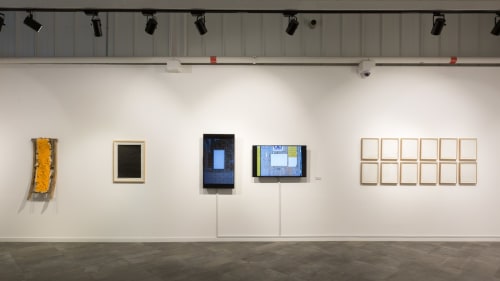
The Monochrome Revisited, installation view, Jean-Paul Najar Foundation (2019)
Hassan Sharif included in the exhibition The Monochrome Revisited at the Jean-Paul Najar Foundation, Dubai, UAE.
Institution's press release:
United Arab Emirates, DUBAI – The monochrome is considered to be one of the most accomplished forms of painting. The importance of the monochrome lies in its conception, in its artistic and philosophical principles, and for some, in its ability to address social concerns. Kazimir Malevich’s Black Square (1915) is considered to be the first monochrome in the history of art. But can the origin of the monochrome be situated prior to the early twentieth century?
The Jean-Paul Najar Foundation (JPNF) presents The Monochrome Revisited, an exhibition that explores the history and evolution of the monochrome. The exhibition is divided into three parts: the first section focuses on the ‘first monochromes’ found in printed matter from the seventeenth to the nineteenth centuries, putting into question its genesis; the second section takes its inspiration from Marcia Hafif’s seminal text Beginning Again, illustrating her purpose with selected works; and the final part of the exhibition looks at how artists today continue to be preoccupied with the monochrome, engaging with it in their practice to explore contemporary issues.
In late 2015, an announcement was made at the State Tretyakov Gallery in Moscow that incited controversy. Art historians at the national museum had discovered, under Kazimir Malevich’s iconic composition Black Square (1915) a scrawled reference to a provocative work sardonically titled Negroes Fight in a Tunnel by poet Paul Bilhaud. First exhibited in 1882 at Les Arts Incohérents, Bilhaud’s politically incorrect work (today considered to be the first documented monochrome) intended to simultaneously ridicule modernism as it acknowledged its radicalness. Fifteen years later, in 1897 Alphonse Allais published Album primo-avrilesque, which featured a number of works including Paul Bilhaud appropriated black monochrome. This section of the exhibition looks at this publication as well as others including Robert Fludd’s (first published in 1617) masterwork Utriusque cosmi maioris scilicet et minoris metaphysica, physica atque technica historia (The Metaphysical, Physical and Technical History of the Two World, the Major as well as the Minor) and Laurence Sterne's The Life and Opinions of Tristram Shandy, Gentleman (1759-1767).
The second part of the exhibition takes as its core Marcia Hafif’s influential essay Beginning Again, published in Artforum in 1978. Throughout her fifty-year artistic career, Hafif, sought to push against any notion that “the enterprise of painting”1 had come to an end. She writes, “It was necessary to turn inward to the means of art, the materials and techniques with which art is made. Artists still interested in painting began an analysis – or destruction – of painting, turning to the basic question of what painting is.”2 We pay homage to Hafif and the important artists she references in her text exploring not only their use of material and technique but the contemplative attributes they bestow onto the monochrome. Artists include James Bishop, Dale Henry, Ralph Humphrey, Douglas Sanderson, Lucio Pozzi, and Susanna Tanger. The exhibition then looks at how these artists elaborated and expounded on the art form, giving a deeper understanding of monochrome painting.
Finally, we look at how contemporary artists today engage with the monochrome. Working across various mediums including painting, photography, and the ready-made, the monochrome has once again undergone an evolution, as artists redefine what it is and what it can be. Contemporary artists such as Miya Ando, David Batchelor, Alteronce Gumby, Alfredo Jaar, Mohammad Kazem, and Hassan Sharif demonstrate the vitally important role the monochrome continues to play in contemporary art. A provocative and innovative art form to this day, the monochrome retains the power to address contemporary issues, challenging our perception of the world we live in.
The Monochrome Revisited
October 25, 2018 – February 28, 2019
Jean-Paul Najar Foundation
45 Alserkal Avenue
PO Box 928040
Dubai, UAE